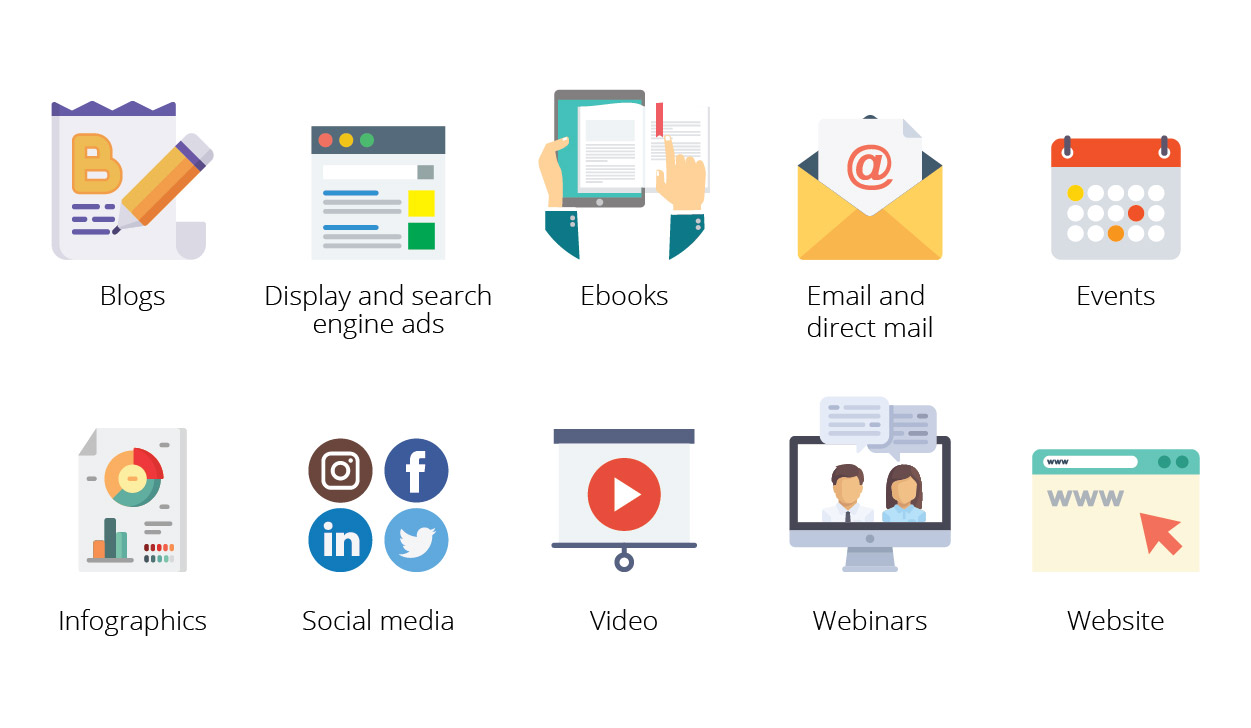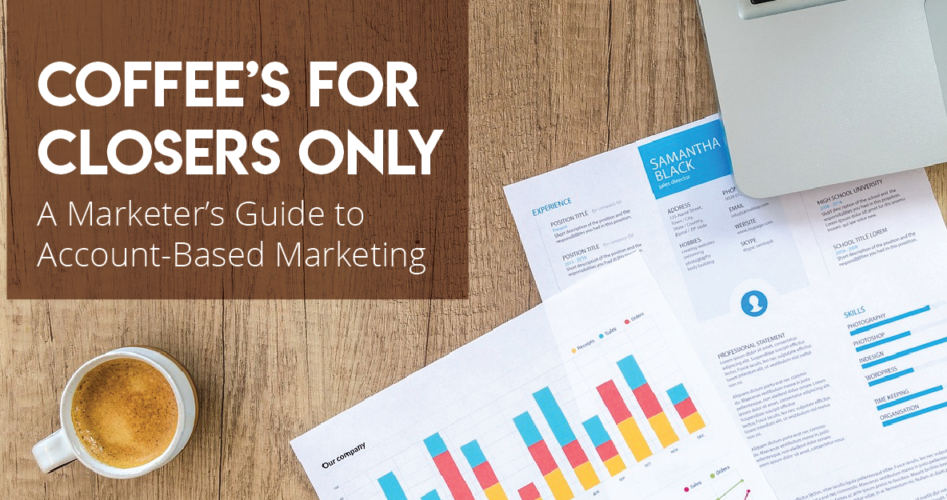“Put that coffee down! Coffee’s for closers only.”
This intense, hair-raising scene in the 1992 masterpiece Glengarry Glen Ross sparked a new interest in modern marketing decades ago and continues to stand the test of time. Even today, marketers and sales professionals go to great lengths to close a deal – often spending weeks and months to devise the perfect strategy. Although the ideal scenario would involve different teams working in tandem to create a thorough and well-planned strategy, it’s a rarity. So if you’re a marketer reconsidering the way you’ve always worked, ask yourself these questions:
- Why isn’t your marketing plan closely aligned with your sales strategies?
- Why do sales, marketing, and creative teams continue to work in silos?
Account Based Marketing (ABM) is a game-changing tactic that can answer these questions and help you excel in the competitive ecosystem. But before we delve deep into this subject, let’s understand the difference between traditional B2B marketing and ABM.
Traditional B2B marketing in a nutshell
The purpose of traditional B2B marketing is clear – to maximize lead generation by broadcasting as much content as possible. Marketers do this by being loud, clear, and visible through a host of communication channels – be it paid, earned, or owned. The biggest priority with these traditional methods is to cast a wide net and grab the attention of varied audiences.
But what if you could be smarter and more targeted in your approach? What if you could rethink how you leverage demand generation and inbound marketing, or use technology to your advantage? This is where ABM comes in.
How does account-based marketing compare?
ABM is an alternative B2B marketing strategy that focuses resources and sales on specific accounts – treating them as a ‘market of one’. How, you ask? Through personalized marketing campaigns that resonate with the target audience and help further your goal – whether you’re trying to make your first sale, renew contracts, upsell or cross-sell your services and products, or encourage advocacy.
When it comes to targeting, traditional B2B strategies might be as accurate as arrows but account-based marketing is a sniper. ABM promises the highest return on investment in comparison to any other technique and boasts a 47% response rate from stakeholders. That’s not all, when supported with smart and scalable technology, it allows marketers to accomplish more with fewer processes and risks.
Get started with ABM
Are you ready to make a difference to your marketing and sales strategies with ABM? Then just follow this step-by-step guide.

Step 1: Get your team together
The first and most crucial step to successfully leveraging ABM is having the right team in place. It’s imperative to assemble the sales, marketing, and creative teams to set expectations, KPIs, goals, etc. prior to the planning phase. While the size and the members involved in this team will differ based on your unique organizational requirements, these professionals will form the core:


Step 2: Work on your strategy
Kudos, you’ve assembled your team! Now, it’s time to put your heads together and define your objectives because these form the foundation of your ABM strategy. Common goals for an ABM strategy can include anything from launching a new product and entering new markets to building market share and targeting specific accounts. And if you’re not sure where to begin, here are four ways to help you adopt account-based marketing.
- One-on-one ABM
Remember the popular TV series, Mad Men, where the characters focused on closing select high-value accounts? That’s exactly what 1:1 ABM entails – a strategic and customized approach to not more than 1 to 10 accounts at a time. This is ideal for enterprise-level accounts and demands highly personalized content and experiences. Although 1:1 ABM is the most resource-intensive model, and the least scalable one, it promises high ROI and value for both organizations. Which is why 1:1 ABM is not done to clients, but with them.
- ABM Lite
If you’re attempting to crack into a new segment using this strategy without taking a big risk, ABM Lite is the way to go. This one-to-few model includes customized programs aimed at a few accounts, typically 5-10, with common needs and pain points. ABM Lite targets accounts with similar business attributes, initiatives, challenges, and objectives – and complements the efforts with personalized content.
- Programmatic ABM
Programmatic account-based marketing can be the most scalable method of targeted and personalized marketing – provided you have the right tools and technologies. This allows you to target up to 1,000 accounts at a time.
So how is it different from traditional marketing methods? Standard lead-based strategies involve channels of mass marketing, such as print, broadcast, and direct mail, to drive maximum conversions. And unlike targeted account-based marketing, these traditional methods often generate a lot of noise, but are incapable of filtering the right leads. Programmatic ABM, on the other hand, is enabled by smart technology that allows you to scale up and target progressively larger groups efficiently and cost-effectively.
- Bolt-on ABM
A fundamental truth about B2B marketing is that you’re not selling to individuals, but to organizations. Marketers are often required to engage with a group of decision-makers while still communicating with one specific lead – something that contradicts the process of lead-based marketing.
Bolt-on ABM leverages technology and triggers actions to help you qualify and nurture inbound efforts. This strategy allows you to engage individuals from a specific company, create opportunities for conversion, and enhance account engagement. And although you may not get the same results as targeted one-on-one ABM, Bolt-on is a positive first step in your transition from lead-based marketing to account-based marketing.

Step 3: Leverage the power of technology
ABM technology is a great way to engage with your customers across multiple channels, allowing you to connect with more than just an individual lead. While the best people and the right strategies can give your ABM campaigns a great start, you still need relevant technologies to take it one step further. Thanks to technology, you have the liberty to personalize marketing strategies basis different campaigns, personas, and activities.
- Advertising: These technologies allow you to expand engagement with set audiences, retarget visitors who return to your site, and optimize web conversion through digital platforms such as video, social, display, and mobile ads
- Automated marketing: A scalable tool to boost pre-sale and post-sale engagement, these Marketing Automation Platforms (MAPs) provide support through traditional marketing tactics and outbound email marketing. In addition, they also include functions such as linking contact profiles with their activity, account-scoring functionalities, and other features to enable effective sales and execution
- Automated sales-force: From account management and reporting to lead management and a host of other applications, ABM largely relies on automation platforms to manage contacts, accounts, and opportunities. In addition, many companies also use these platforms to oversee sales assets in an effort to define insights and content. It’s no wonder then that one-third of the companies undertaking ABM are investing in sales-force automation tools
- Customer intelligence and analytics: Predictive analytics and insight-driven tools allow organizations to channel their sales and ABM efforts in the right direction. Some of the most common solutions in customer intelligence management include handling feedback, collecting and analyzing data, and formulating responses. This information is gathered from various touch-points to better understand customers. That’s not all, with the help of further insights, you can improve messaging, engagement, segmentation, etc. and better target your customers
In addition to these platforms, you can also explore automation tools for social media management, Content Management System (CMS), and more to help boost your current ABM strategy.

Step 4: Find the right channels
Now that you’ve got your A-team and your best strategy, it’s time to execute it through the right channels. Fortunately, ABM can be propagated through multiple ways, such as:

Step 5: Measure your success

The definition of success changes from one strategy to another. However, there are a few common metrics you can track to measure the results of your ABM strategies. Account-based marketing doesn’t bring instantaneous results but when done right, it reduces your sales cycle length i.e. the time taken to close high-value accounts. By nurturing a decision-making process, accelerated by sharing relevant and educational content beforehand, you stand to make a sale much faster.
Start by tracking your progress with specific engagement metrics such as click-throughs and secondary actions across multiple devices, accounts, and personas. You can also consider your website’s engagement by comparing page views, clicks, and conversion rates. In addition to engagement metrics, you should keep an eye on your revenue – how many target accounts have you converted into valuable customers who stay? A simple way to calculate this is by comparing the average deal value of traditional marketing programs with your ABM campaigns.
The final word
While traditional B2B marketing methods have their own merit, only a few have proven to be as effective as ABM. With the right measures in place, you too can excel in this intensive and rewarding exercise. All you have to do is remember your ABCs – Always Be Closing!

